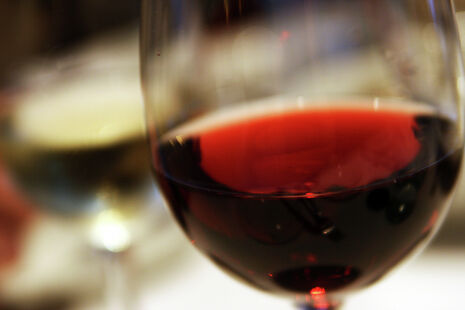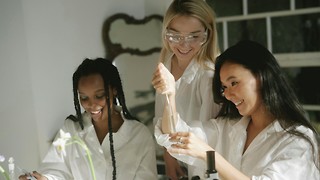Decanting the chemistry of wine
Madeline Kavanagh hits the bottle, for science, at the Cambridge Alumni Festival

“Oakey, with a long finish”, “full-bodied, with fruity flavours”, and “richly coloured with ‘good legs’”. With comments like these you could be forgiven for thinking you were at any generic wine tasting event, right? Wrong. When safety goggles and lasers appear, and terms such as anthocyanins, malic acid and light-scattering start getting bandied about without anyone blinking an eye, something must be up.
The room was full; tastebuds expectant; shining glasses waited to be filled with mysterious liquids from masked bottles. The three ‘expert’ wine connoisseurs readied themselves at the front of the room, checking over their revision notes one final time, while some less experienced guests sipped on tannin-rich tea before the tasting commenced. This was no average wine tasting event: this was the Cambridge Alumni Festival “Call My Bluff” Wine Tasting extravaganza! Four rounds of wine tasting, country-of-origin identification and a factual quiz, all guided by an expert panel from the Department of Chemistry comprised of the current Head of Department Professor Daan Frenkel, Professor of atmospheric chemistry John Pyle, and materials chemist Dr Silvia Vignolini.
The experts provided entertaining commentary – although possibly of doubtful accuracy – throughout the evening, with Professor Frenkel demonstrating the sometimes spurious relationship between observations and deductions, remarking in Round One that as the wine had “no reflection” it must “come from the country of Dracula”. Furthermore, supporting Frenkel’s optical data, a wine sporting “the opulent aroma that the Prince of Darkness loves so much” led to the conclusion that the mystery wine could only be a Pinot Grigio from the Carpathian mountains.
The incoming Head of Department, Professor Pyle, took a rather more sophisticated approach when drawing his conclusions, although hardly any more scientifically robust. Brandishing red, blue and green lasers – while appropriately attired in safety spectacles of course – Pyle concluded from the different levels of light absorption that the wine must contain a high proportion of sulphites and was thus likely to be of low quality. Sulphites, like sulfur dioxide, are chemicals that are produced naturally by yeast during the wine fermentation process, but they are also typically added to wines to kill bacteria, to improve shelf life, and to prevent oxidative processes that cause discolouration. A range of other valuable scientific techniques were demonstrated throughout the evening, including Dr Vignolini’s innovative use of pH indicator strips to assess the acidity of the sample, and more modern technologies, such as various smartphone apps to unsuccessfully “research” the answer.
Guests were educated throughout the event on the numerous finer points by which chemistry impacts wine production. From the overall flavour and palate of a wine, which is predominately influenced by the balance of sugars (glucose and fructose), acids (malic, tartaric and lactic) and organic compounds (called phenols) to the various esters, terpenes and other volatile aromatics which contribute to the aroma of a wine. Other factors include the effects of atmospheric chemistry and climate change on grape maturation, the fine balance that exists between “good” microbes (like the yeast required for fermentation or the Botrytis fungi responsible for giving a sauterne its sweetness) and pests (such as the dreaded grape blight, caused by the Phylloxera vastatrix aphid, which threatened to wipe out the French wine industry in the mid-19th century).
As the evening drew to a close and the teams jostled for top-spot on the score-board, bonus points were awarded for completing “feedback” questionnaires. The 100 per cent return rate clearly demonstrated that striving for a first is not a characteristic Cambridge graduates grow out of. So, with the sun setting, the bottles rapidly emptied, and our experts’ ability to identify grape varieties diminishing at the same rate, it’s clear that the success of this first-time event for the Cambridge Alumni Festival will surely lead to a repeat performance. Perhaps it’s no coincidence that chemistry fellows are over-represented amongst college wine stewards!
 News / Cambridge don appointed Reform adviser23 October 2025
News / Cambridge don appointed Reform adviser23 October 2025 News / Uni commits to partial arms divestment after year-long review20 October 2025
News / Uni commits to partial arms divestment after year-long review20 October 2025 Theatre / Ibsen’s Ghosts transfixes the Corpus Playroom22 October 2025
Theatre / Ibsen’s Ghosts transfixes the Corpus Playroom22 October 2025 Comment / On overcoming the freshers’ curse22 October 2025
Comment / On overcoming the freshers’ curse22 October 2025 Arts / Why Cambridge’s architecture never lives up to the ‘dark academia’ dream 17 October 2025
Arts / Why Cambridge’s architecture never lives up to the ‘dark academia’ dream 17 October 2025








